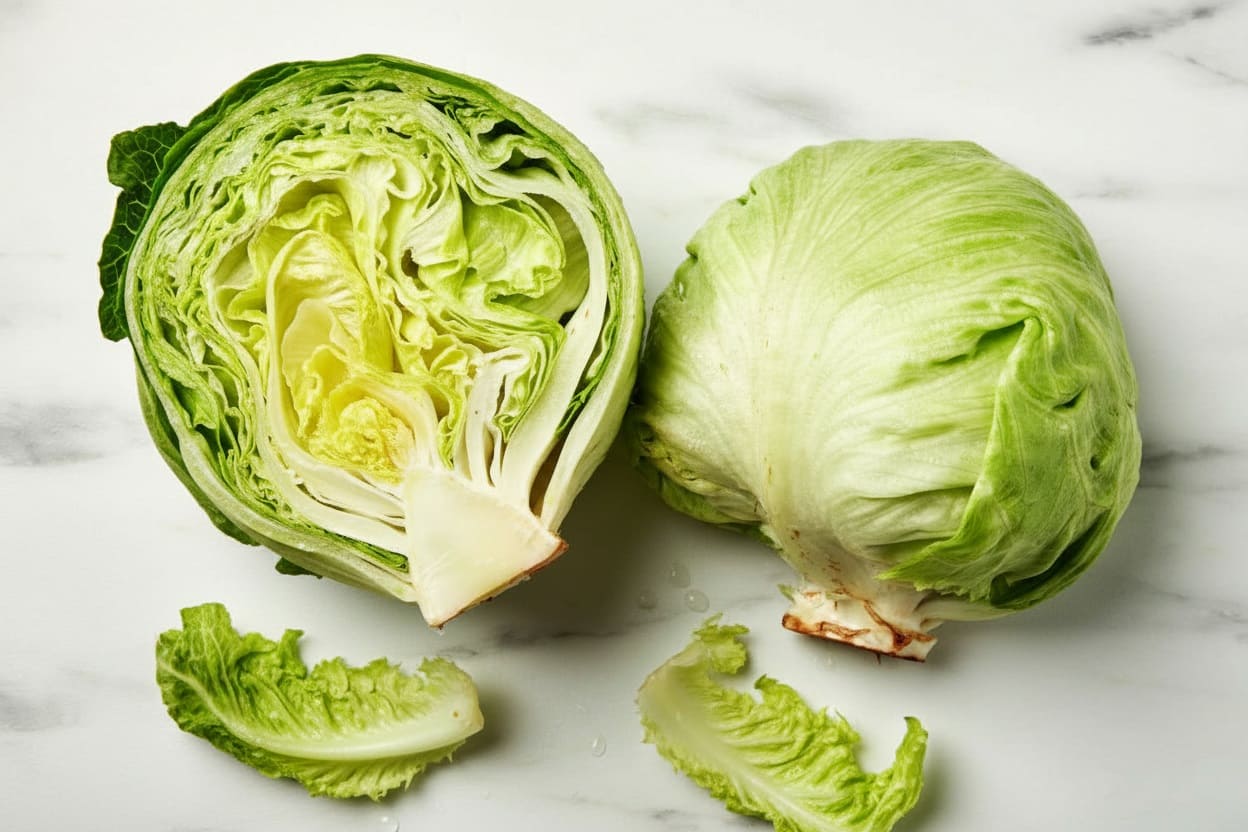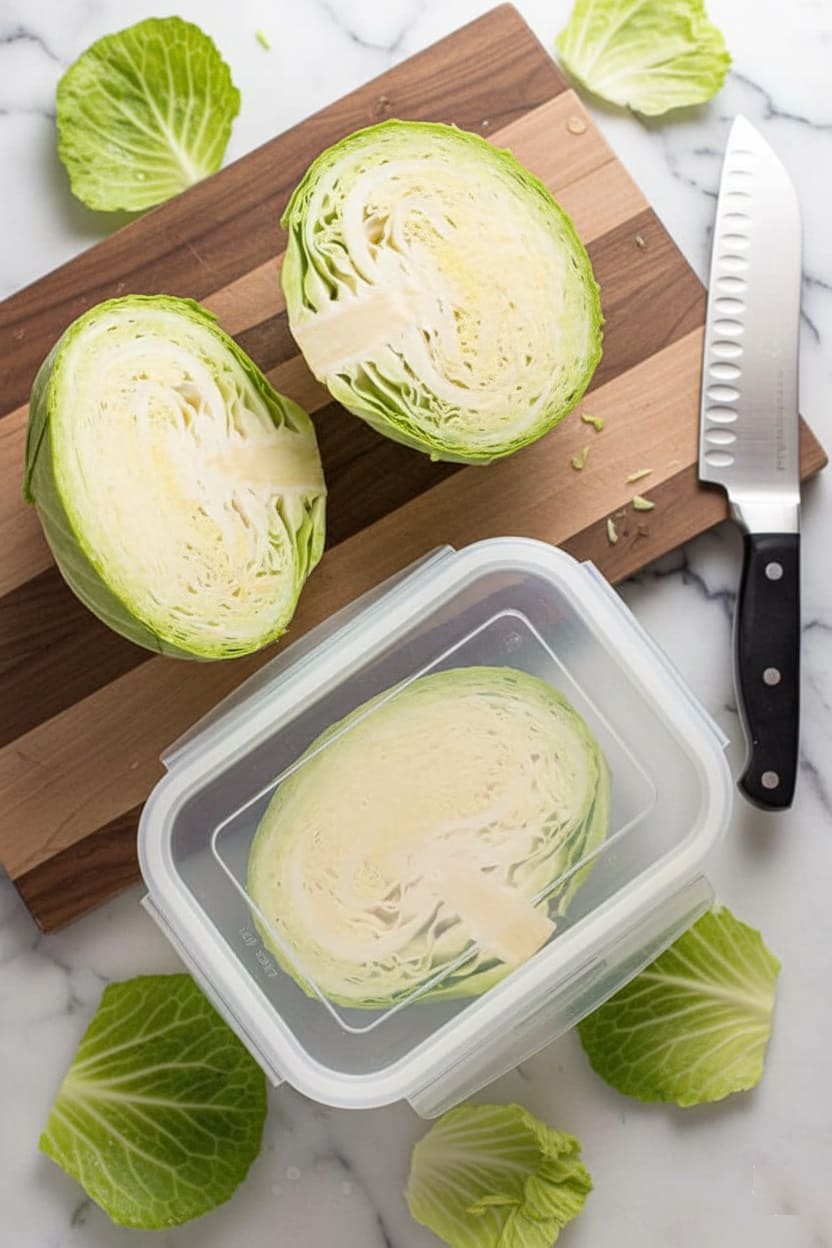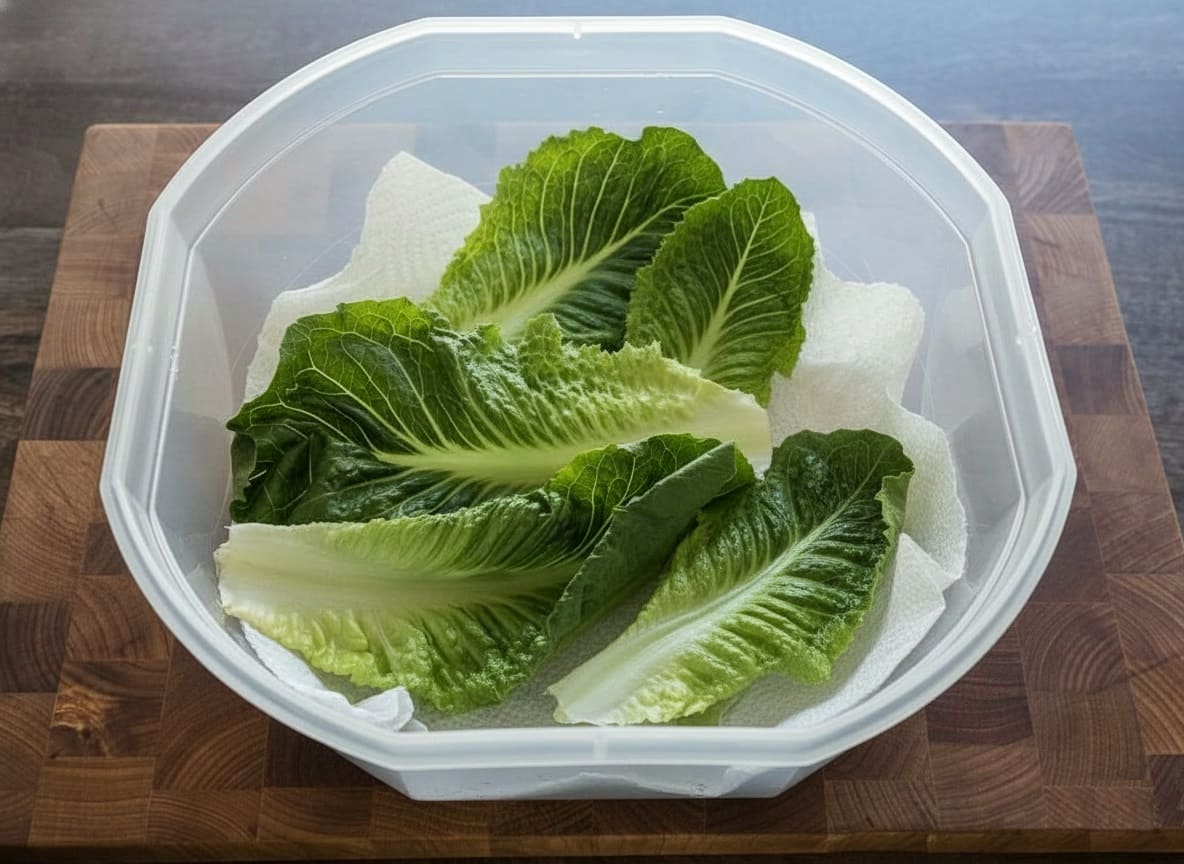Standing in the produce aisle, staring at a head of iceberg lettuce and green cabbage, you’re not entirely sure which is which.
Here’s the truth most people discover too late: these leafy greens might look like twins, but they’re completely different vegetables with unique nutritional profiles, flavors, and kitchen uses.
By the end of this guide, you’ll know exactly when to reach for crisp lettuce and when cabbage deserves the spotlight—plus which one aligns better with your health goals and cooking style.
Why Cabbage and Lettuce Aren’t Even Cousins
Lettuce belongs to the Asteraceae family, sharing botanical roots with daisies, sunflowers, and artichokes.

Cabbage comes from the Brassicaceae family alongside broccoli, cauliflower, and kale—the cruciferous vegetable powerhouses known for their health benefits.

This family difference explains why they taste, cook, and nourish your body so differently. Understanding this distinction is your first step toward using each vegetable to its full potential.
How to Tell Them Apart at a Glance
While green cabbage and iceberg lettuce can fool you from across the produce section, a closer look reveals clear differences.
Pick up a similarly-sized head of each. The cabbage feels surprisingly heavy and dense—almost solid—while the lettuce feels light and airy. That weight difference comes from how tightly the leaves pack together and their water content (cabbage is 92% water, lettuce 95%).
Look at the texture. Cabbage leaves have a smooth, almost waxy feel with a subtle springiness. Lettuce leaves are softer and more delicate, especially the inner ones.
Cabbage also has a distinct pungent, slightly peppery aroma that’s immediately noticeable, while lettuce is virtually odorless.
The color offers another clue. Lettuce tends toward richer, more vibrant greens due to higher chlorophyll content, while cabbage often appears paler, especially toward the center.
The Nutritional Showdown: Which Wins?
When it comes to sheer nutritional density, cabbage takes the crown, but lettuce brings its own valuable contributions to your diet.
Cabbage: The Nutrient-Dense Champion
In 100 grams of raw cabbage, you’re getting 25 calories alongside impressive nutrition: 61% of your daily vitamin C needs (compared to lettuce’s mere 4%), 96% of vitamin K, and 2.5 grams of fiber—roughly double what lettuce provides.
Cabbage also delivers significant amounts of vitamin B6, folate, calcium, and manganese.
The real superstar in cabbage is sulforaphane, a sulfur compound that research links to cancer prevention. Studies suggest it may help delay melanoma, breast, prostate, and pancreatic cancers.
Red cabbage adds anthocyanins—powerful antioxidants that fight inflammation and protect cells from damage. These compounds are why cabbage smells distinctive when cooking, and they’re also why it’s considered one of the healthiest vegetables you can eat.

Lettuce: The Hydration and Vitamin A Hero
Don’t dismiss lettuce as just crunchy water. While it contains only 15 calories per 100 grams, darker varieties like romaine pack serious nutrition.
Lettuce provides over 50 times more vitamin A than cabbage—crucial for vision, immune function, and skin health. It also offers good amounts of vitamin K (85% of daily needs), folate, and beneficial antioxidants like beta-carotene and lutein for eye health.
The catch: not all lettuces are created equal. Iceberg is mostly water with minimal nutrients, earning its reputation as the least nutritious option.
Romaine, red leaf, and darker varieties deliver significantly more vitamins and minerals. Remember this simple rule—the darker the leaves, the more nutritious the lettuce.

Lettuce’s high water content (95%) makes it excellent for hydration and weight management. Its volume-to-calorie ratio is impressive, helping you feel full without adding significant calories to your diet.
Taste, Texture, and Kitchen Performance
This is where cabbage and lettuce diverge dramatically, determining how you should use each one.
Cabbage has a robust, slightly peppery flavor when raw that mellows and sweetens as it cooks. The texture is dense and crunchy, with leaves sturdy enough to withstand heat, pressure, and time.
You can sauté it, braise it for hours, or pickle it, and it maintains structure. That distinctive cabbage aroma when cooking? Those are the sulfur compounds (the same ones delivering health benefits) being released. Quick cooking in well-ventilated spaces minimizes the smell.
Lettuce offers mild, refreshing flavor with a crisp, watery texture. It acts as a neutral canvas that enhances other ingredients without competing for attention.
The downside? Heat is lettuce’s enemy. Cook it for more than a minute or two, and you’re left with soggy, wilted disappointment. Lettuce shines when served fresh and raw.
Smart Buying: What to Look For
When buying cabbage, choose heads that feel heavy for their size with tightly packed leaves. The outer leaves should look fresh, not wilted or yellowed. Avoid any with soft spots or browning at the base where it was cut.
Cabbage is typically most affordable and flavorful during fall and winter, though it’s available year-round. At $0.50-1.00 per pound, it’s one of the most budget-friendly vegetables available.
When buying lettuce, look for crisp leaves without browning edges or wilted spots. The base should look freshly cut, not dried out or discolored. Avoid any heads with slimy or damaged leaves.
While lettuce is available year-round thanks to extensive supply chains, it’s best during spring and fall when it grows most naturally. Expect to pay $1.50-3.00 per head depending on variety, making it generally more expensive than cabbage per serving.
How to Prepare and Cut Cabbage Safely
Many people struggle with cutting cabbage, but it’s straightforward once you know the technique.
Start by removing any damaged outer leaves. Place the cabbage on your cutting board with the stem side down. Using a large, sharp knife, cut the cabbage in half from top to bottom through the core.
For wedges, simply cut each half into 2-3 pieces. For shredding (ideal for slaws and stir-fries), place each half cut-side down and slice crosswise into thin ribbons—about 1/8 to 1/4 inch thick works well.
The core is tough and unpleasant to eat, so either cut it out before shredding or remove it from your serving.
If you’re making cabbage rolls, you’ll need whole leaves. Carefully remove the outer leaves one at a time, or briefly blanch the whole head in boiling water to soften the leaves for easier removal.
Kitchen Applications: When to Use Which
Cabbage’s Versatility
Raw cabbage excels in coleslaws, where its crunchy texture holds up against creamy or vinegar-based dressings without getting soggy. Thinly shredded, it adds satisfying crunch to tacos, sandwiches, and salads.
For Asian-style slaws, napa cabbage’s mild flavor and tender texture work beautifully.
Cooking transforms cabbage. Sautéing quickly over high heat with garlic creates a simple side dish with a slight char.
Braising low and slow in liquid produces melt-in-your-mouth tenderness with concentrated sweetness—perfect for pairing with rich meats.
Roasting cabbage wedges at high heat caramelizes the edges, creating what’s often called “cabbage steaks.” Steaming keeps things light and preserves more nutrients.
Fermentation unlocks cabbage’s probiotic potential. Sauerkraut and kimchi aren’t just flavorful condiments—they’re gut-health powerhouses that can last months in your fridge while developing complex, tangy flavors.

👉 Here’s How to Can Vegetables: Complete Beginner’s Guide to Safe Home Canning
Lettuce’s Fresh Focus
Lettuce is the foundation of virtually every salad, from simple garden salads to composed dishes like Caesar or wedge salads.
The variety you choose matters: butterhead’s tender leaves work beautifully with delicate vinaigrettes, romaine’s sturdy ribs hold up to heavy Caesar dressing, and iceberg’s neutral crunch complements bold ingredients.
Beyond salads, lettuce creates crisp layers in sandwiches and burgers without adding competing flavors. Lettuce wraps offer a low-carb alternative to tortillas—use sturdy leaves like butter lettuce or romaine for filling-heavy wraps.
Some people even add romaine to green smoothies for vitamins without a strong vegetable taste.
The occasional exception: grilling romaine hearts or briefly wilting lettuce in Asian-style dishes can work, but timing is critical. Aim for barely warmed through rather than fully cooked.
Managing Cabbage’s Digestive Effects
Cabbage’s fiber and sulfur compounds can cause gas and bloating, especially when eaten raw or in large quantities. If you’re sensitive, several strategies help:
Start with smaller portions and gradually increase as your digestive system adapts.
Cooking cabbage breaks down some of the compounds that cause gas, so cooked cabbage is often easier to digest than raw. Quick cooking methods like stir-frying are gentler than long boiling.
Adding carminative spices—fennel seeds, caraway, cumin, or ginger—while cooking can reduce gas formation. These spices have been traditionally used with cabbage dishes for this exact reason.
If raw cabbage bothers you, try fermented versions like sauerkraut, which contain probiotics that may actually improve digestion.
Most importantly, listen to your body. If a full cup of raw cabbage causes discomfort, try a quarter cup and see how you feel.
Storage Strategies for Maximum Freshness
Cabbage is remarkably shelf-stable. Store the whole unwashed head in your refrigerator’s crisper drawer, wrapped loosely in plastic or in a plastic bag.
It’ll stay fresh for 2-3 months, making it one of the best vegetables for reducing food waste and stretching your grocery budget.
Once cut, wrap the remaining portion tightly in plastic wrap and use within 2-3 days. Don’t wash cabbage until you’re ready to use it—excess moisture accelerates spoilage.
Lettuce requires more careful handling. Wash and thoroughly dry it as soon as you get home (moisture on the surface causes rot).
Wrap the clean, dry lettuce in paper towels to absorb any remaining water, then place it in a plastic bag or airtight container in the crisper drawer.
Most varieties last 5-7 days; iceberg can push 10 days. Living lettuce sold with roots in clamshell containers can last up to 18 days and retains more nutrients.
Growing Your Own: Garden Considerations
If you’re thinking about growing your own greens, here’s what you need to know:
Lettuce loves:
- Cool weather (spring and fall)
- Partial shade (too much sun makes it bitter and causes it to bolt)
- Well-drained, sandy soil with pH 6-7
- Consistent moisture
- Quick maturity (45-90 days depending on variety)
👉 Discover more Fast Growing Vegetables Ready in 60 Days or Less
Cabbage prefers:
- Cooler temperatures (can tolerate light frost)
- Full sun (6-8 hours daily)
- Various soil types with pH not exceeding 6.5
- Plenty of space (leaves need room to develop)
- Longer growing season (80-180 days)
- More nutrients and fertilizer
Lettuce is generally easier for beginners, while cabbage can be more challenging due to pest susceptibility and longer growing times.
Popular Varieties Worth Knowing
Understanding the varieties helps you choose the right one for your recipe.
- Green cabbage is the workhorse—affordable, versatile, and available everywhere. Its mild flavor and sturdy texture work for nearly any application.
- Red or purple cabbage offers the same versatility with extra antioxidants and a gorgeous color that brightens salads (add a splash of vinegar or lemon juice when cooking to maintain its vibrant hue).
- Savoy cabbage has crinkled, tender leaves with a milder, sweeter taste ideal for quick cooking or eating raw.
- Napa cabbage features an elongated shape and delicate flavor that’s essential for kimchi and works beautifully in Asian dishes.
- Bok choy brings crisp white stems and dark green leaves perfect for stir-fries.
- Iceberg lettuce offers maximum crunch and the longest shelf life but minimal nutrients—think of it as a texture vegetable rather than a nutrition source.
- Romaine delivers the best nutritional bang among common lettuces, with sturdy ribs perfect for Caesar salads.
- Butterhead varieties like Boston and Bibb have soft, sweet leaves ideal for wraps and delicate salads.
- Red and green leaf lettuces provide tender, flavorful leaves excellent for mixed salads. Each brings something different to your table.
When to Choose Cabbage vs. Lettuce
Choose cabbage when you want maximum nutrition, need something that lasts weeks in your fridge, plan to cook your greens, or want robust flavor.
It’s also your go-to for fermented foods, hearty winter dishes, and budget-conscious shopping. Cabbage’s sturdiness means it travels well and won’t wilt in lunchboxes.
Choose lettuce when you’re making fresh salads and sandwiches, want hydration support, need vitamin A, or prefer mild, neutral flavors that won’t compete with other ingredients.
Lettuce is ideal for warm-weather dishes, showcasing delicate dressings, and creating visual appeal with its brighter green color.
That said, don’t think of this as either/or. The smartest approach uses both vegetables for their strengths. Keep cabbage for cooking and long-term storage, and maintain lettuce for fresh, immediate use.
Your Questions Answered
- Can I substitute cabbage for lettuce in salads?
Yes, thinly shredded cabbage works well in salads, especially when you want extra crunch and nutrition.
However, its stronger flavor and firmer texture are different from lettuce, so consider it a complement rather than a direct replacement. Mixing both often yields the best results.
- Why does cooking cabbage smell?
Those sulfur compounds (like sulforaphane) create the distinctive aroma. It’s actually a sign of the healthy compounds at work. Minimize the smell by cooking quickly over high heat with good ventilation rather than boiling for extended periods.
- Can I eat raw cabbage?
Absolutely. Raw cabbage is delicious in slaws and salads when sliced thinly. Start with small amounts if you’re not used to it, as raw cabbage can cause gas in some people. The thinner you slice it, the easier it is to chew and digest.
- Which lettuce is healthiest?
Romaine and red leaf lettuce top the charts. The darker the leaves, the more vitamins, minerals, and antioxidants they contain. Iceberg has its place for texture and hydration, but it’s the least nutritious option.
- Does cooking destroy cabbage’s nutrients?
Some nutrients are lost, but many remain, and some (like beta-carotene) become more available to your body when cooked.
Quick cooking methods like stir-frying or steaming preserve more nutrients than long boiling. Fermented cabbage gains beneficial probiotics that raw cabbage doesn’t have.
- How do I know when to harvest homegrown cabbage?
Heads should feel firm and solid when squeezed. Size varies by variety, but most are ready when heads reach 1-3 pounds. Harvest before hot weather arrives, as heat causes cabbage to split and become bitter.
👉 Learn When and How to Harvest Vegetables for Peak Flavor: Timing & Tips for Every Crop
The Bottom Line
Cabbage and lettuce both deserve regular spots in your kitchen, but for different reasons.
- Cabbage brings superior nutrition, longer storage, cooking versatility, and budget-friendly value.
- Lettuce offers fresh crunch, hydration, vitamin A, and the perfect neutral base for showcasing other flavors.
Rather than choosing sides, think of them as teammates. Use cabbage in your cooked dishes, ferments, and hearty slaws where its robust character shines.
Keep lettuce on hand for fresh salads, sandwiches, and dishes where its delicate texture and mild flavor work best.
The real winner is you when you understand how to leverage each vegetable’s unique strengths to create more flavorful, nutritious meals.
Ready to put this knowledge to work?
This week, try making a classic coleslaw with cabbage and a fresh salad with your favorite lettuce variety. Notice how different they taste, feel, and satisfy in their own ways.
Share your favorite cabbage or lettuce recipe in the comments—we’d love to hear what’s working in your kitchen.




